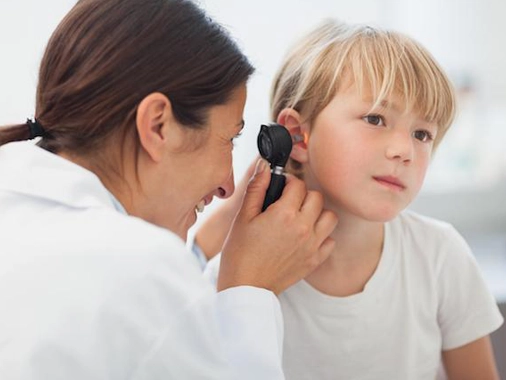
Middle ear fluid in children can manifest as reduced hearing or a feeling of fullness in the ear. Very young children may describe this condition as “my ear hurts.” Although it is not necessarily a true pain, children often describe it this way.
Middle ear fluid can develop after a middle ear infection caused by bacteria, commonly known as “otitis media,” or it may be related to enlarged adenoids. This is a significant problem in children because hearing loss affects them much more than adults. It can lead to falling behind at school, decreased academic performance, and in severe cases, permanent hearing loss.
To detect middle ear fluid, we first examine the eardrum. We also perform a middle ear pressure test. For children aged 4–5 years and older, hearing tests (audiometry) can be conducted.
Initially, treatment of middle ear fluid may involve antibiotics and allergy management if necessary, followed by observation over a certain period. Follow-up can last 1–2 months, depending on the season and the individual patient.
However, if the first hearing test shows hearing loss above 25–30 decibels, we may shorten the follow-up period for these children. This is because, over time, middle ear fluid can become more viscous.
It can stick the small bones in the middle ear together, cause calcifications, and lead to permanent hearing loss. This is an outcome we want to avoid in children.
For patients whose follow-up period has passed and where intervention becomes necessary, we drain the fluid from the ear and perform a tube insertion procedure to restore proper ear function.
This surgery is performed under general anesthesia, meaning the child is asleep and does not feel anything. A small incision is made in the eardrum, and the middle ear fluid is drained. This procedure can immediately improve hearing.
To prevent recurrence of infection and fluid buildup, a small tube—shaped like a spool with a hole in the middle—is placed in the eardrum. This tube typically stays in place for an average of 12 months (ranging from 6–15 months) and usually falls out on its own. During follow-up appointments, we monitor the tube’s condition.
In most children undergoing this procedure, removal of the adenoids is also included. In other words, ear tube placement and adenoid removal are often performed together. After 4–5 hours of observation following the procedure, the child can usually go home on the same day.
Another factor that determines the need for middle ear surgery in children is the frequency of ear infections. If a child has had three middle ear infections in the past six months or four infections in the past year, we may decide to place an ear tube. Middle ear infections often cause more severe pain, fever, and loss of appetite.
While acute infections can be treated with antibiotics, repeated infections may necessitate tube placement to prevent further infections and permanent damage. Adenoid removal is typically performed at the same time.
We have observed that ear tube placement combined with adenoid removal significantly improves hearing, positively affects the child’s growth, development, and educational performance, and provides relief from repeated infections. This procedure brings satisfaction to both children and their parents, as well as to the medical team.